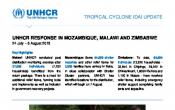Zimbabwe
Operation: Zimbabwe
Location
{"longitude":29,"latitude":-19,"zoom_level":0,"iso_codes":"'ZWE'"}
By clicking on the icons on the map, additional information is displayed.
The boundaries and names shown and the designations used on this map do not imply official endorsement or acceptance by the United Nations.
Key Figures
| 2019 year-end results | |
| 9,200 | refugees and asylum-seekers received cholera vaccinations |
| 2,100 | refugee and asylum-seeking children were enrolled in government-run primary schools |
| 1,100 | new arrivals (500 women and 600 men) were received and registered in 2019 |
| 400 | refugee housing units were delivered and assembled in Tongogara refugee |
| 130 | Zimbabwean returnees from Dukwi refugee camp in Botswana were received in Zimbabwe |
| 460 | teenage girls participated in activities focused on the prevention of sexual and gender-based violence (SGBV) |
| 60 | SGBV survivors received medical and psychosocial assistance |
| 2020 planning figures | |
| 100% | of households will be living in adequate dwellings |
| 100% | of primary school aged children will be enrolled in primary education |
| 100% | of status determination procedures will meet minimum procedural standards advocated by UNHCR |
| 40% | of stateless persons and their situation will be identified |
| 6 | educational facilities will be constructed or improved |
Latest Updates
People of Concern
1,444%
Increase in
2019
2019
| 2019 | 291,583 |
| 2018 | 18,891 |
| 2017 | 18,874 |

[["Refugees",8959],["Asylum-seekers",11533],["IDPs",270000],["Returned refugees",132],["Others of concern",959]]
Loading ...
Zimbabwe
< Back
2019
{"categories":[2015,2016,2017,2018,2019,2020],"budget":[5.80670135,6.43412162,10.957979280000002,7.81785047,11.409489940000002,7.59425855],"expenditure":[4.82715146,4.95217574,7.07456308,5.7709857300000005,9.324982290000001,null]}
{"categories":[2015,2016,2017,2018,2019,2020],"p1":[5.6767914699999995,6.084611440000001,10.525885220000001,7.564022469999999,7.7204812800000004,7.29630655],"p2":[0.12990988,0.34951018,0.43209406,0.253828,0.28500566,0.297952],"p3":[null,null,null,null,null,null],"p4":[null,null,null,null,3.404003,null]}
{"categories":[2015,2016,2017,2018,2019,2020],"p1":[4.704710700000001,4.75229399,6.83835733,5.59678891,7.14654874,null],"p2":[0.12244076,0.19988175,0.23620575,0.17419682,0.20431911,null],"p3":[null,null,null,null,null,null],"p4":[null,null,null,null,1.97411444,null]}
Loading ...
CHOOSE A YEAR
- 2015
- 2016
- 2017
- 2018
- 2019
- 2020
Operational context
In 2019, the socioeconomic and political environment in Zimbabwe remained precarious as the country continued to struggle with fiscal consolidation and financial sector stabilization.The already fragile humanitarian situation was compounded by the impact of Tropical Cyclone Idai. Heavy rains and strong winds caused riverine and flash flooding, affecting 270,000 people including 122,000 in the Chipinge District where the Tongogara refugee camp hosted some 15,000 refugees and asylum-seekers. Approximately 6,000 refugees and asylum-seekers in Chipinge District were severely impacted as over 1,000 houses, latrines and water boreholes were completely or partially damaged.
The Government made seven pledges during the Global Refugee Forum in December 2019 on strengthening its legal, policy and administrative frameworks. The Government also registered seven pledges to end statelessness by 2024.
Population trends
In 2019, Zimbabwe was host to more than 11,500 asylum-seekers and nearly 9,000 refugees (mainly in Tongogara refugee camp). In addition, some 270,000 people were internally displaced across the country.Achievements
- The Government provided 25 hectares of agricultural land for a livelihood programme aimed at refugee and host communities in the Tongogara refugee camp.
- Some 65,000 people from refugee and host communities affected by Tropical Cyclone Idai were assisted with civil status registration and documentation.
- As part of the collective United Nations system response, UNHCR provided core relief items to nearly 66,000 people affected by Cyclone Idai – both Zimbabweans and refugees - and co-led the protection cluster.
Unmet needs
- Limited resources affected UNHCR’s capacity to provide livelihoods and vocational training, especially for women and out-of-school youth.
- There was inadequate learning space for early childhood development and primary schools.
- Lack of sustainable energy sources for cooking led to deforestation in areas surrounding Tongogara refugee camp, exacerbating the risk of SGBV for women and girls while collecting firewood outside the camp.
Operational Environment
The political, operational and security environment in Zimbabwe is expected to remain stable in 2019, resulting in a favourable protection environment for refugees and asylum-seekers. Zimbabwe is a state party to the 1951 Convention on the Status of Refugees, as well as to the 1969 Organisation of African Unity Convention, but maintains reservations on rights to movement, work and social welfare. Zimbabwe has also not yet acceded to the 1961 Convention on Reduction of Statelessness.The Government continues to provide transit centre facilities, land, access to services and social amenities, in-kind donations as well as experienced personnel for the refugee response. Structured coordination mechanisms are in place to facilitate UNHCR’s cooperation with partners. The local host community around Tongogara refugee camp is welcoming people of concern, allowing their sustainable integration through the socio-economic services.
As part of the multi-year, multi-partner protection and solutions strategy, UNHCR will enhance partnerships with the Registrar General, universities, diplomatic representations, NGOs, faith-based organizations and parliamentarians to leverage on the progress achieved in the past for both refugee and statelessness responses. UNHCR will focus on strengthening and diversifying the pool of partners, which will provide the platform for rolling out the Comprehensive Refugee Response Framework (CRRF) in Zimbabwe.
Key Priorities
For the refugee response, priorities will centre on the provision of shelter, healthcare, livelihoods, education and water/sanitation, as well as ensuring child protection, capacity development, strengthening response to sexual and gender-based violence, and facilitation of durable solutions. In order to reduce statelessness, UNHCR will conduct a comprehensive study on statelessness and develop a national action plan.In 2019, UNHCR will focus on:
- Partnership diversification for sustainable protection, assistance and solutions for both the refugee and statelessness programmes;
- Improving the self-reliance of people of concern through diversified and context specific livelihoods activities in line with the principles of the graduation approach;
- Conducting a comprehensive study on statelessness in Zimbabwe, and enhancing the network of partners in implementation of a national action plan to tackle statelessness.














